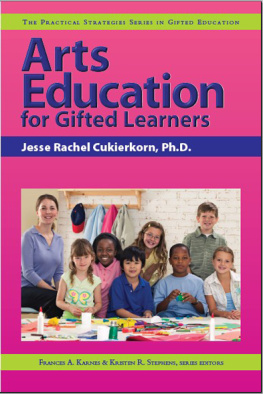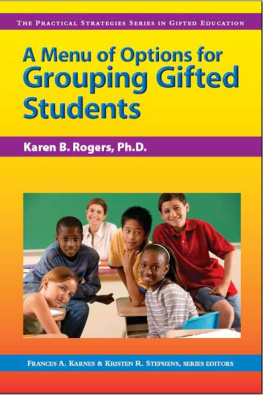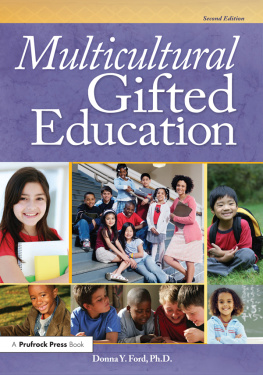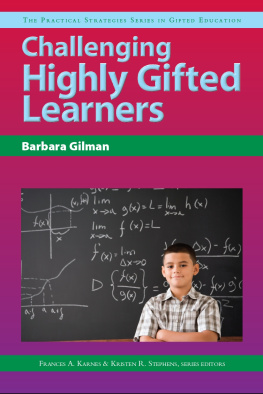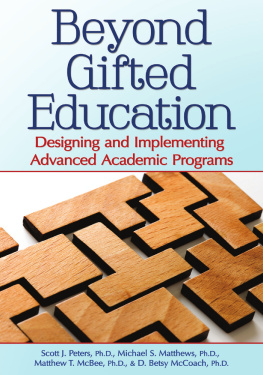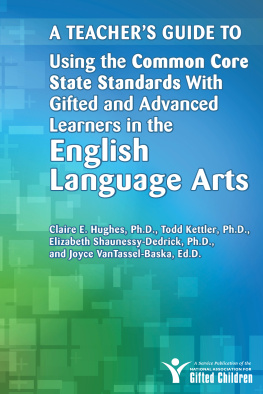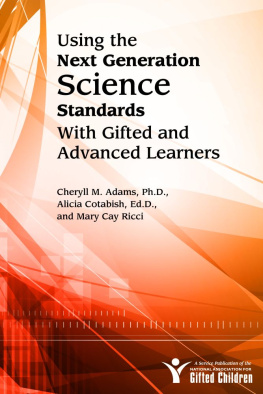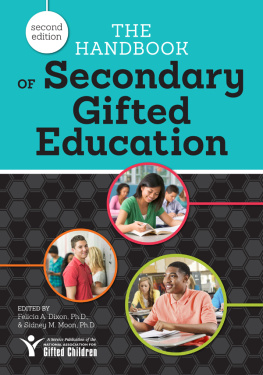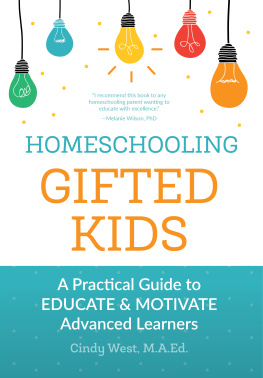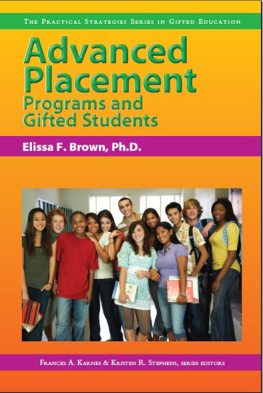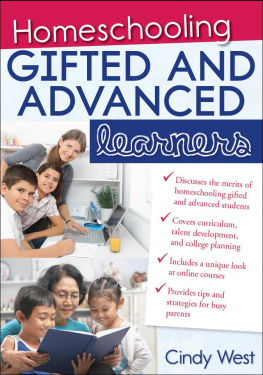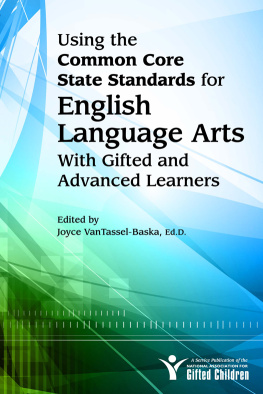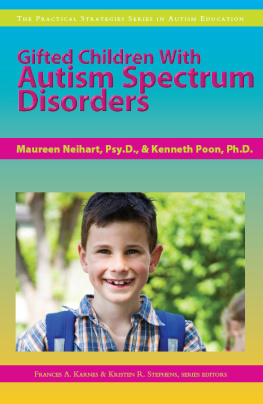Jesse Cukierkorn - Arts Education for Gifted Learners
Here you can read online Jesse Cukierkorn - Arts Education for Gifted Learners full text of the book (entire story) in english for free. Download pdf and epub, get meaning, cover and reviews about this ebook. year: 2008, publisher: Sourcebooks, Inc., genre: Art. Description of the work, (preface) as well as reviews are available. Best literature library LitArk.com created for fans of good reading and offers a wide selection of genres:
Romance novel
Science fiction
Adventure
Detective
Science
History
Home and family
Prose
Art
Politics
Computer
Non-fiction
Religion
Business
Children
Humor
Choose a favorite category and find really read worthwhile books. Enjoy immersion in the world of imagination, feel the emotions of the characters or learn something new for yourself, make an fascinating discovery.
- Book:Arts Education for Gifted Learners
- Author:
- Publisher:Sourcebooks, Inc.
- Genre:
- Year:2008
- Rating:3 / 5
- Favourites:Add to favourites
- Your mark:
- 60
- 1
- 2
- 3
- 4
- 5
Arts Education for Gifted Learners: summary, description and annotation
We offer to read an annotation, description, summary or preface (depends on what the author of the book "Arts Education for Gifted Learners" wrote himself). If you haven't found the necessary information about the book — write in the comments, we will try to find it.
This book explores those characteristics of Advanced Placement courses that provide educational benefit to gifted students.
Arts Education for Gifted Learners — read online for free the complete book (whole text) full work
Below is the text of the book, divided by pages. System saving the place of the last page read, allows you to conveniently read the book "Arts Education for Gifted Learners" online for free, without having to search again every time where you left off. Put a bookmark, and you can go to the page where you finished reading at any time.
Font size:
Interval:
Bookmark:
IN GIFTED EDUCATION
series editors
FRANCES A. KARNES & KRISTEN R. STEPHENS
for Gifted Learners
Jesse Rachel Cukierkorn, Ph.D.

PRUFROCK PRESS, INC.
Copyright 2008 by Frances A. Karnes
and Kristen R. Stephens-Kozak
All rights reserved.
No part of this book may be reproduced, translated, stored in a retrieval system, or transmitted, in any form or by any means, electronic, mechanical, photocopying, microfilming, recording, or otherwise, without written permission from the publisher.
Printed in the United States of America.
ISBN-13: 978-1-59363-774-3
At the time of this books publication, all facts and figures cited are the most current available. All telephone numbers, addresses, and Web site URLs are accurate and active. All publications, organizations, Web sites, and other resources exist as described in the book, and all have been verified. The authors and Prufrock Press, Inc., make no warranty or guarantee concerning the information and materials given out by organizations or content found at Web sites, and we are not responsible for any changes that occur after this books publication. If you find an error, please contact Prufrock Press, Inc. We strongly recommend to parents, teachers, and other adults that you monitor childrens use of the Internet.
| Prufrock Press, Inc. P.O. Box 8813 Waco, Texas 76714-8813 (800) 998-2208 Fax (800) 240-0333 http://www.prufrock.com |
The Practical Strategies Series in Gifted Education offers teachers, counselors, administrators, parents, and other interested parties up-to-date instructional techniques and information on a variety of issues pertinent to the field of gifted education. Each guide addresses a focused topic and is written by an individual with authority on the issue. Several guides have been published. Among the titles are:
- Acceleration Strategies for Teaching Gifted Learners
- Curriculum Compacting: An Easy Start to Differentiating for High-Potential Students
- Enrichment Opportunities for Gifted Learners
- Independent Study for Gifted Learners
- Motivating Gifted Learners
- Questioning Strategies for Teaching the Gifted
- Social & Emotional Teaching Strategies
- Using Media & Technology With Gifted Students
For a current listing of available guides within the series, please contact Prufrock Press at (800) 998-2208 or visit http://www.prufrock.com.
How is talent defined in a young artist? What is the role of art education in gifted education? How much value is placed on the arts in school and at home? These questions face many parents and educators, especially when a child shows a great affinity for making art, music, or dance and is interested in improving his or her abilities in these areas. Current beliefs and values about art and art education guide parents and teachers as they nurture a child who is talented in the visual or performing arts. Confidence in art, as a critical and complex experience, is the first step in supporting the artistically talented student. Over time, there are several different ways in which teachers and parents can follow through, maintain, and support an artistically talented child.
The general goals of this volume are to increase awareness of artistic expression, reveal the characteristics of artistically talented students, describe program options, and share an approach for supporting the affective needs of these students. Compared to other countries, the United States has very little support for the arts in education and in society. Rare gifts and talents often are untapped and untaught, with just a portion of the population with artistic talent being served. Furthermore, there still is much to be learned in terms of understanding these students abilities and needs. Talented individuals have the potential to make terrific contributions to the art and culture of society. Practical strategies and resources are needed to foster artistic expression and to ensure that artists can excel in their respective fields.
Many children enjoy participating in the arts and excel in these activities. However, it is very difficult for educators and parents to gauge achievement in the arts unlike achievements in academic and intellectual pursuits. While the twofold term gifted and talented often is used in education and in the Javits Act (1988), many states distinguish giftedness from talent in their regulations for serving youth by defining separate categories for intellectually gifted and artistically talented. Gagn (2003) distinguished giftedness from talent more clearly. In his model, giftedness means the possession and use of untrained and spontaneously expressed natural abilities (called aptitudes or gifts) in at least one domain to a degree that places a child among the top 10% of his or her age peers. In contrast, talent designates the superior mastery of systematically developed abilities or skills and knowledge in at least one area of endeavor to a degree that places the child among the top 10% of his or her age peers who are active in that field (Gagn, 2003). The following section provides profiles of four young artists, all of whom attend programs with extensive admission criteria and who have demonstrated advanced achievement by winning top awards or scholarships within their school or program. From these profiles and others, it becomes evident that setting high expectations for achievement in the arts and making contact with other artists are powerful components of talent development.
Tobias has stood out from his peers for his creative abilities in dancing and singing since he was in the second grade. In elementary school, he received encouragement from enthusiastic teachers who emphasized lessons in creative movement. Tobias admitted that, at first, he was not always serious about his abilities. He initially danced, sang, and performed in musical theatre due to the accolades that he received and because people said that he was really good at it. Only later did one of his instructors at the arts conservatory teach him to have faith in his own abilities and ownership of the drive to perform. This instructor taught Tobias that each and every time he is performing he has to tell the story whether he is acting, singing, or dancing. At 17, Tobias feels that he is now a completely different person, because he has the passion for performance.
Tobiass mother lets him focus on the things that he loves. Although he has a B average in high school, she is not overly concerned about his grades. Tobias feels that his mothers willingness to let him focus on his creative abilities has contributed greatly to the development of his talent.
At the age of 13, Ashlee began attending a cluster arts magnet program without any previous training in writing. In the sixth grade, one of her teachers read several of her short stories, recognized her potential, and recommended that she audition for the program. Although the audition process intimidated her, she was excited to learn that there was such a place for her to be creative.
Ashlee sees the depressing environment of her low-income neighborhood as a negative motivator. She says that it drives her to be even better because she doesnt want to be like the people around her in the neighborhood. Once she is alone, in her own room, she can block out all of the negative influences of the neighborhood by putting on music and writing while she sits on her bed. In contrast, Ashlee feels inspired when she leaves her home high school to attend the cluster arts magnet school. She feels that the environment, both school and neighborhood, is safer. The other students are open for discussions and are really welcoming. There arent as many cliques as compared to her home school, and she doesnt feel as inhibited because there is less fear about what others might say about her writing.
Font size:
Interval:
Bookmark:
Similar books «Arts Education for Gifted Learners»
Look at similar books to Arts Education for Gifted Learners. We have selected literature similar in name and meaning in the hope of providing readers with more options to find new, interesting, not yet read works.
Discussion, reviews of the book Arts Education for Gifted Learners and just readers' own opinions. Leave your comments, write what you think about the work, its meaning or the main characters. Specify what exactly you liked and what you didn't like, and why you think so.

